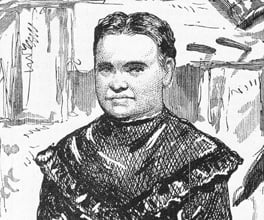Australia's first commune
Johann Frederick Krumnow was the charismatic and self-appointed leader of 'Herrnhut', Australia’s first commune based between Penshurst and Hamilton in Western Victoria.
On the 27 May 1853, Krumnow and his followers purchased 642 hectares of Crown Land for £1584. His followers were part of the Moravian Church, an evangelical Protestant movement originally from Bohemia in Germany. Krumnow had converted most of his followers while he was based in Collingwood. They were predominantly farmers, carpenters, blacksmiths, saddlers, masons and other craftsmen.
While Krumnow had a reputation as being both charismatic and very popular with his female followers, he cut an unusual figure in the remote community of Hamilton:
He was a little, deformed man, something like the German gnome which Mr. Wertheim has chosen to picture as the motto for his sewing machines. His face was dark and wrinkled, his hair, black, long and unkempt. In public he always wore an overcoat of black cloth and latterly of opossum skin, which, with a broad-crowned German military "cheesecutter" cap, completed a costume which, as I have said, was characteristic of the man.
- The Hamilton Spectator, 1880.
The Hamilton Spectator, November 16, 1880.
In the wider community the people at Herrnhut were often referred to as ‘The Peculiar People’ because of their strange beliefs. In the commune all money and property belonged to the collective and members were not allowed to seek medical help. Medical conditions could only be treated with prayer.
In 1875, Maria Heller established another Moravian commune, Hill Plains, near Tungamah in Victoria after emigrating with 50 to 75 followers from Wilhelmsdorf, in the German state of Silesia. Like Krumnow, she was an eccentric character who spoke poorly, but with what she claimed was divine inspiration:
[S]he had the respect of simple peasants, some of whom vowed that God spoke through her. She, too, believed this, especially when in a trance.
- Richard Trahair
Trahair, R C S 1999 Utopias and Utopians : an historical dictionary, Greenwood Press, Westport, Connecticut.
Hill Plains immediately faced difficulties as members struggled to find ways to feed themselves. Within months eight members of the commune had died of malnutrition and most others had contracted scurvy.
Nearly starving, Maria Heller accepted Krumnow’s invitation to join his commune. She and the remaining members of Hill Plains travelled 500 kilometres across Victoria to Herrnhut.
While the two charismatic leaders seemed to get along very well initially, they quickly began to disagree about leadership and after a year Maria Heller was charged with being a dangerous lunatic for trying to assault Krumnow with a rock. She was found guilty. Heller left Herrnhut for the nearby town of Tabor in November 1876 where she married and no longer claimed to have her gift.
By the time Krumnow died in 1880, the Herrnhut commune was heavily in debt. Only eight members remained. Frau Elmore took over leadership of the commune but she was unable to inspire her followers. Herrnhutt finally collapsed after 44 years in 1897. It remains the longest running commune in Australia’s history.











